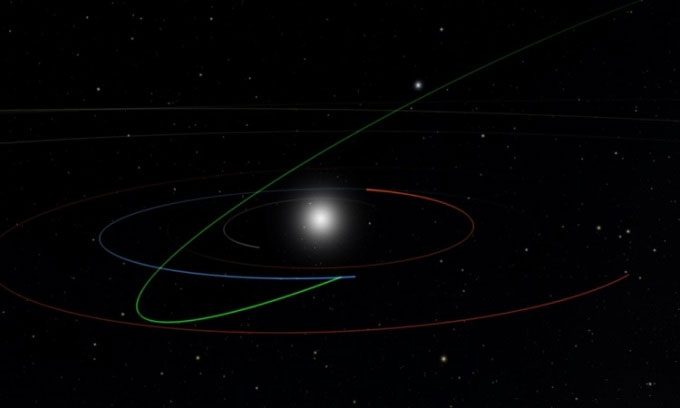New Algorithm Helps Researchers Identify Potentially Hazardous Asteroids Flying Near Earth Undetected
Astronomers have discovered a skyscraper-sized asteroid lurking near Earth, thanks to a new algorithm designed to hunt for the largest hazardous meteoroids, Live Science reported on August 2. The 180-meter asteroid named 2022 SF289 is large enough and orbits close enough to Earth to be classified as a Potentially Hazardous Asteroid (PHA). This category includes approximately 2,300 similar objects that could cause widespread damage to Earth if they were to collide.

Orbit of asteroid 2022 SF289 (green) during its closest approach to Earth (blue orbit). (Image: Joachim Moeyens)
The newly discovered asteroid passed near Earth in September 2022, at a distance of 7.2 million kilometers, according to NASA. However, astronomers worldwide were unable to identify it in telescope data at any time before, during, or after that close approach due to the large meteoroid being obscured by the starlight of the Milky Way.
Currently, researchers are aware of the existence of 2022 SF289 while testing a new algorithm specifically designed to detect large asteroids from small data fragments. Discovering a PHA that is so difficult to find using traditional methods underscores the significant potential of the algorithm.
The algorithm, named HelioLinc3D, will soon be used to analyze data collected by the Vera C. Rubin Observatory, an advanced telescope in the Chilean mountains, which is expected to start asteroid hunting in early 2025, according to Mario Jurić, director of the Institute for Enhanced Data in Astrophysics and Cosmology at the University of Washington and the lead developer of the algorithm.
To identify its first asteroid, scientists tested the algorithm with data collected from the Asteroid Terrestrial-impact Last Alert System (ATLAS) in Hawaii. ATLAS captures at least four images of the same point in the sky each night. The search process revealed that the object ATLAS missed was a large asteroid that could be seen through three separate sky images taken on September 19, 2022, and three nights later.
ATLAS requires an object to appear in four separate images in one night before it can be classified as an asteroid. Since 2022 SF289 did not meet this criterion, researchers were never aware that it had flown near Earth. Meanwhile, the HelioLinc3D algorithm can filter out asteroids from much less data.
Jurić’s team believes that 2022 SF289 is just the beginning for Rubin and the algorithm. There could be thousands of hidden PHAs orbiting Earth waiting to be discovered.


















































